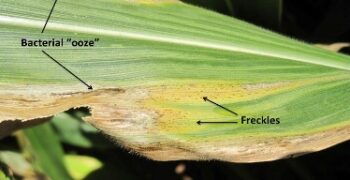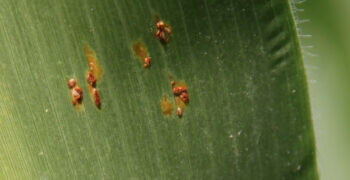Symptoms:
The virus that causes Maize Dwarf Mosaic Virus (MDMV) has also been identified as Sugarcane Mosaic Virus (SCMV), they both have been sourced to infect corn fields across the United States and Canada. The virus is spread by multiple species of aphids. Infection of the plant can be determined by mosaic patches of dark and light green coloring on the leaves that can turn into narrow streaks on the youngest leaves. Internodes shortening can also occur, stunting the plant. While narrow streaks appear on the youngest leaves, red streaks can appear on older leaves. Infected plants may have small ears with aborted kernels or barren. When temperatures rise and plants mature, symptoms will often disappear. Young plants are the most susceptible to the virus, becoming infected at the seedling stage, if infection occurs at pollination or after, plants will often look normal or not affected. Laboratory tests will be needed to confirm Maize Dwarf Mosiac that are commonly confused with nutrient deficiencies, other viral diseases and other physical disorders.
 Scouting:
Scouting:
Maize Dwarf Mosaic Virus overwinters mainly in Johnsongrass and then transmitted by aphids, infecting the corn plant. Other grasses can also host the virus, such as sorghum. The virus can survive up to 6 hours on the mouth of aphids and they can be carried northward on the wind currents. Average to warm temperatures favor the development of the disease.
Management:
- Plant resistant hybrids.
- Managing weeds such Johnsongrass and others will greatly reduce the chances of MDMV.
- Planting corn early to avoid seedling susceptibility and high aphid populations will greatly reduce infection.



